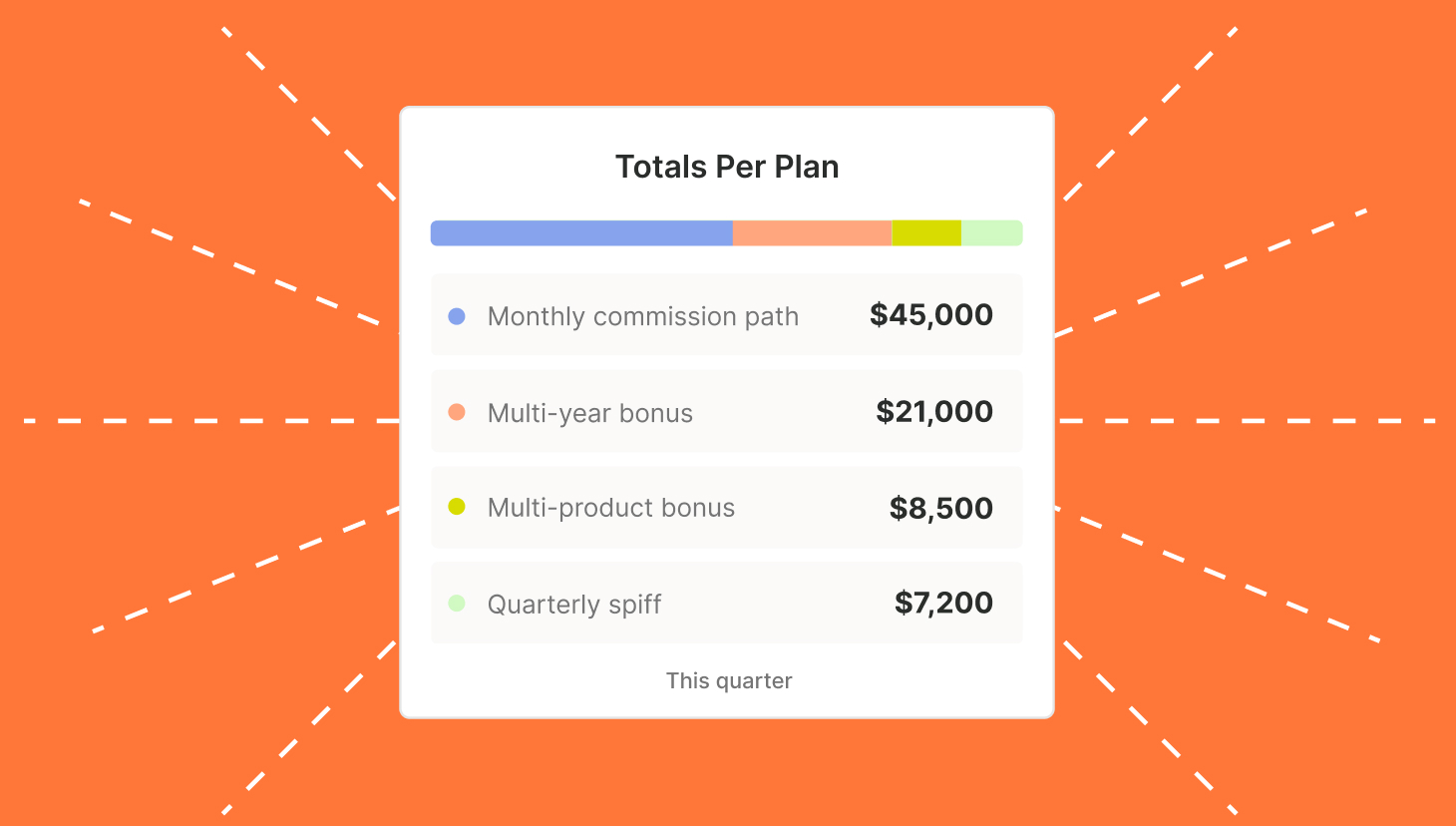Does the perfect compensation plan exist?
We’ve certainly found some great ones. However, we’ve also seen pretty painful ones.
For example, comp plans that cap commissions never end well.
“A cardinal sin for sales reps is sandbagging, which occurs when a rep holds deals this month to earn more money next month. Capped commissions are a major contributor to this behavior,” our Chief of Staff Graham Collins said.
On the other hand, a simple and consistent comp plan that includes uncapped commissions and allows for reps to make up on lost ground if they miss a month promotes positive sales rep behaviors. Take comp plans that feature monthly quota bonuses. These keep incentives up each month while mitigating sandbagging.
Create Compensation Plans with confidence
RevOps, sales leaders, and finance teams use our free tool to ensure reps’ on-target earnings and quotas line up with industry standards. Customize plans with accelerators, bonuses, and more, by adjusting 9 variables.
Build a Comp Plan“The right kind of sales compensation plan will reward desired behaviors and foster more consistent performance on a monthly, quarterly, and yearly basis,” said our CEO and Founder AJ Bruno.
But the impact of a “perfect” comp plan extends well beyond rep behaviors.
“Appropriate sales compensation plans aren’t just the sign of a healthy organization; they’re tools to motivate sales reps and power company-wide growth,” AJ said.
Solid comps have also been linked to higher sales rep retention rates and larger percentages of teams hitting quotas consistently. Plus, a pretty compensation plan attracts new hires, which continues to remain top of mind for any growing sales org.
Comp plan best practices
AJ’s got a soft spot for the classic 50/50 ratio when the plan assumes bookings versus annual and monthly recurring revenue.
That means 50 percent of a rep’s on-target earnings (OTE) consist of base salary and 50 percent being variable. A flat percent on anything the rep closes, paired with bonuses for hitting monthly and quarterly bonuses, leads to comp plan bliss.
This plan is a beaut for its simplicity, consistency, and incentivization of overperformance.
For more tips to reach that perfect plan, we’ve outlined seven compensation planning best practices.
1. Align your comp plans to business goals.
First and foremost, “Sales comp is the caboose, not the engine.” That’s our friend Pablo Dominguez’s motto as it pertains to comp plans. The operating partner of sales and customer success for Insight Partners (one of our investors) suggests designing a plan that supports the business strategy. So, start with your company goals, then let that act as a blueprint for your comp plan.
2. Keep it simple.
Another tip, avoid novella-length comp plans. Better yet, fit it on a napkin. If it’s multiple pages, you’ll lose your reps. As a leader, you’ll also find it more difficult to explain. Shorter comp plans connect all parties involved, like RevOps, finance, sales, leadership, and accounting, through a common understanding.
“Plans should be so simple, that someone could explain it to you in about 15 seconds.”
AJ Bruno, QuotaPath CEO and Co-Founder
3. Set fair and realistic quotas.
Every company wants to shoot for the moon, but when the moon isn’t remotely possible, companies won’t even reach the clouds.
To set a fair quota, look at your sales teams’ history. What percentage of your team hits quota every time? Anything less than 60 percent indicates too high of a quota. On the flip side, 100 percent attainment suggests your quota is too easy. Try to identify the intersection where ambitious meets achievable. Fair and realistic quotas will drive business goals and keep reps motivated. Whereas the opposite fosters defeat and negativity, which feeds employee attrition.
Additionally, it’s important to provide an appropriate ramp-up time for new hires. Whether that’s through lower quotas the first three months or draws, align your ramp-up period to your sales cycle. Meaning, if your sales cycle is three months, one month of ramp up won’t cut it. Another way to offer new hires chances to hit quota is by setting commissionable milestones that help them hit the floor running. In practice, this could look like completing workshops, booking meetings, or opening up new opportunities.
4. Introduce comp plans in a timely manner.
Want to get your reps frustrated over their comp plans before they even see them? Delay sharing them with your team well into the new year.
By introducing your comp plans in a timely manner, you’ll establish trust with your reps. Lead a training session with them. Discuss changes and provide the “why.” Address their questions. Keep it 100. This will build trust and motivate them.
Extra credit if you can get these finalized, signed, and returned before the new year. A sales kickoff scheduled within the first few weeks of the new year is also a great time for comp plan rollouts.
5. Be transparent about how commissions are calculated and when they are paid.
Another opportunity to pump transparency into your comp plan is to show how commissions are calculated and when they are paid out. Do reps see their commissions when the customer signs the contract, or is it paid upon the customer’s first payment? Make it clear. Make it consistent, and don’t leave reps wondering when they’ll finally see their sales hit their bank accounts.
Bonus tip: QuotaPath’s platform is a great way to execute on all seven best practices, and especially this one.
Try QuotaPath for free
Try the most collaborative solution to manage, track and payout variable compensation. Calculate commissions and pay your team accurately, and on time.
Start Trial6. Research market OTEs.
Our sixth best practice focuses on OTEs. Base salaries for sales reps are steadily increasing year-over-year. According to the recruiting platform Zippia, national account executive salaries in the U.S. earn an average salary of $95,300 before commissions. That’s a 3.1 percent jump from 2020 to 2021 and marks the largest YoY spike over the past decade.
So, a lesson to all of us scaling our sales orgs this year, make sure your OTEs rise with industry data. We’d love to say money isn’t everything, but it turns out, money continues to be the biggest reason people leave jobs.
For tips on how to split salaries and commissions, here are the most common we’ve seen:
- Sales representative OTEs usually consist of 50 percent base and 50 percent commission.
- Lead gen roles may have a higher base and lower commission, like a 60 percent base and 40 percent commission.
- Account managers will often have an even higher percentage of OTE made up of base salary. An example could be 70 percent base and 30 percent commission.
- Enterprise sales reps OTEs with large deal sizes could split between a 40 percent base and 60 percent commission.
7. Conduct ongoing evaluations of comp plans but try to avoid too many changes.
Lastly, a comp plan shouldn’t remain static, but it also shouldn’t be changed multiple times a year. Continue to evaluate your comp plans. Note what has worked effectively and what hasn’t, and use these updates to shape the next year’s.
“Too many changes or complications in a short period of time can muddy the waters, obscuring progress toward goals and hurting morale,” AJ said.
In conclusion, the perfect comp plan exists for your business, but it’ll take research, experimentation, and evaluation to get there. When you drum up the perfect plan fitted for your business, expect to see happier reps and a healthier sales org.



